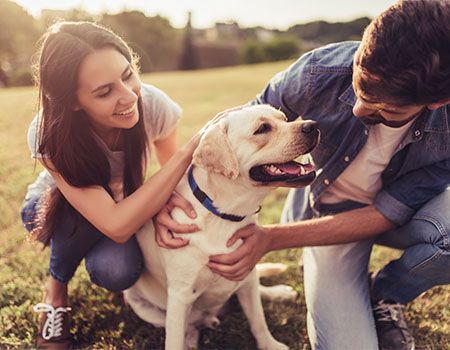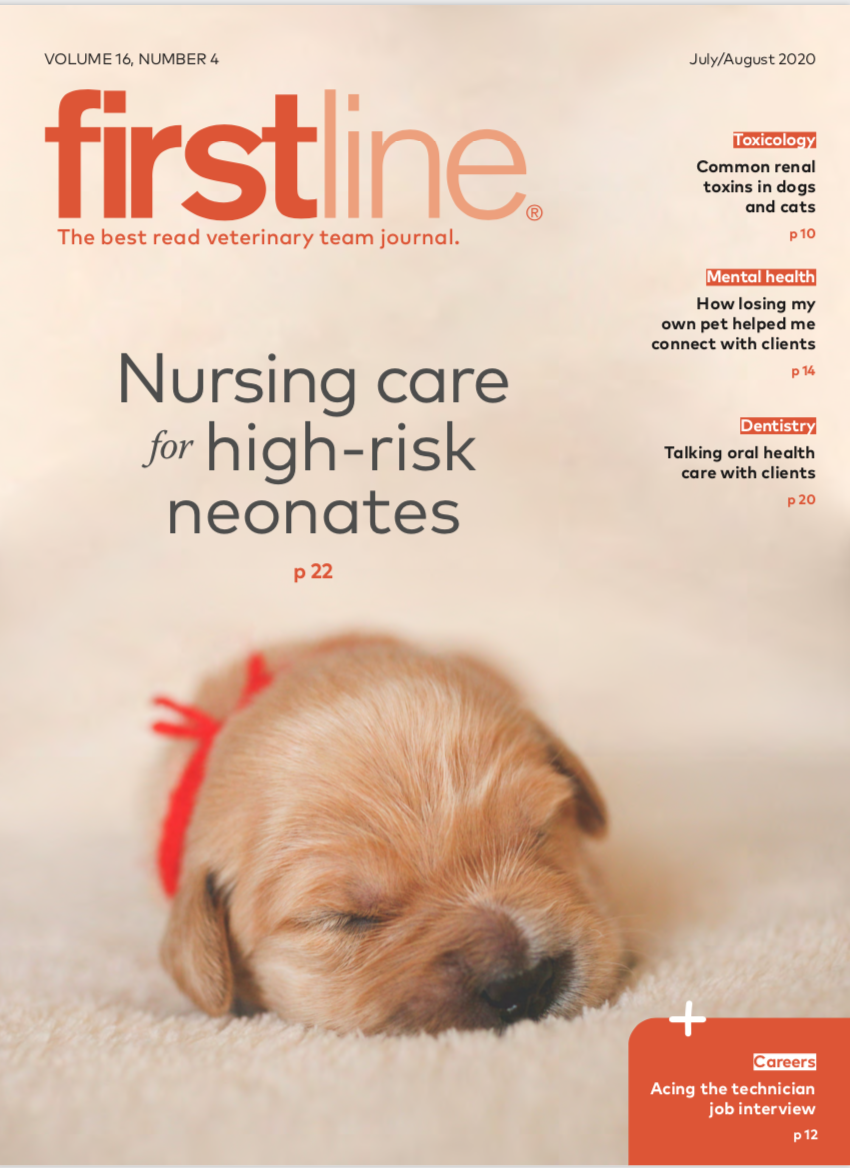How the human-animal bond is reshaping veterinary care
Study of the human-animal bond (HAB) began with psychiatry and psychology and bloomed into the world we live in today. Learn more about HAB, its history and its future in your practice.
Vasyl/stock.adobe.com

While the current focus on the human-animal bond (HAB) feels new(ish) to many, the roots for exploring the connection between healing and wellbeing in humans through relationships with pets, therapy animals and more go back in time as well as into our future.
A whirlwind tour through HAB history
The term “human-animal bond” was coined in the 1960s when Austrian zoologist and ethologist Konrad Lorenz, MD, PhD, became known for his principle of attachment, or imprinting, by which a bond is formed between a newborn animal and its caregiver. In 1969, Boris Levinson, PhD, professor of psychology at Yeshiva University, published the book Pet-Oriented Child Psychotherapy based on his discovery in his psychotherapy practice that when his dog Jingles was in the room, a child would speak more freely. He later coined the term “pet therapy.”
In the mid-1970s other visionaries founded the Delta Foundation (which became the Delta Society) as a clearinghouse for research involving animal-assisted interventions and the HAB. In 1981, William McCulloch, DVM—brother of one of the Delta Foundation founders—helped start the AVMA's Human-Animal Bond Task Force.
Putting this research to work resulted in the development of the Pet Partners program, the first comprehensive, standardized training in animal-assisted activities and therapy for volunteers and health care professionals. In 2012, the Delta Society formally changed its name to Pet Partners, and the organization continues to grow across the United States.
During the 1980s and 1990s, hunches and observations moved to research and documentation. Alan Beck, ScD, and Aaron Katcher, MD—a psychiatrist at the Center for the Human-Animal Bond at Purdue's School of Veterinary Medicine—co-wrote Between Pets and People: The Importance of Animal Companionship, in which they cited a 1992 study of 5,000 people that revealed that pet owners had lower blood pressure and blood fat levels than non-pet owners.
Another of the recent contributors to the field is Philip Tedeschi, who serves as executive director of the Institute for Human-Animal Connection at the University of Denver within the Graduate School of Social Work. He launched the school's Animal-Assisted Social Work Certificate program for master's of social work students as well as the Animals and Human Health online professional development certificate program. Inspiration for the program began when Tedeschi was a student of veterinary medicine at the University of Wisconsin. As a student, he moonlighted teaching horseback riding to adults with schizophrenia. As he recognized positive changes in the riders, he became fascinated with human-animal interactions.
“Increasingly, it is becoming clear that humans' optimum health and resiliency occurs in the presence of other healthy living systems,” he writes on the University of Denver website, “whether it is a pet in our home … or recognition that our global biodiversity health and ecological systems provide us a needed life support system.”
Where HAB research stands today
The burgeoning field of psychoneuroendocrinology has brought into focus understanding of the presence of important hormones like serotonin, oxytocin, dopamine and endorphins. Of particular interest to those researching the human-animal bond is the presence of oxytocin. This has long been advertised as a “love hormone,” made in the hypothalamus, stored and released by the posterior pituitary gland in the brain.
In 1992, documentary producer Meg Daley Olmert joined a team studying the neurobiology of social bonding headed by Carol Sue Carter, PhD, of the University of Maryland. This inspired Daley Olmert to write the 2009 book Made for Each Other: The Biology of the Human-Animal Bond, in which she chronicles the study of oxytocin.
Daley Olmert points out that oxytocin was first identified in 1902 as the hormone that acts on the muscles of the uterus to produce labor contractions. Some 50 years later it was discovered that this hormone produces the spasms that release breast milk. In the 1980s, scientists realized there was even more to the oxytocin story. When released, the hormone produces a feeling of love and satisfaction and is the primary hormone released during an orgasm. Not only does it cause new mothers to form a loving bond with their babies after their birth, but it's related to sexual arousal, trust and more general bonding.
This plays out in the benefits of the human-animal bond that Pet Partners shares online:
- A therapy dog has a positive effect on patients' pain level and satisfaction with their hospital stay following total joint arthroplasty.
- Fibromyalgia patients spending time with a therapy dog instead of in an outpatient waiting area at a pain management facility showed significant improvements in pain, mood and other measures of distress.
- A walking program that matched sedentary adults with therapy animals resulted in an increase in walking over a 52-week graduated intervention, with participants saying they stuck with the program because “the dogs need us to walk them.”
- The presence of an animal can significantly increase positive social behaviors among children with autism spectrum disorder.
- Children made fewer errors in match-to-sample categorization tasks in the presence of a dog compared with a stuffed dog or human. Similar studies may indicate that presence of a dog serves as both a source of motivation and a highly salient stimulus for children, allowing them to better restrict their attention to the demands of the task.
- Therapy animals in pediatric cancer studies improved motivation to participate in treatment protocol, to maintain motivation over time and to want to “get better” or stay optimistic.
- Pet ownership, perhaps by providing social support, lowers the blood pressure response to mental stress.
- Pet owners have higher one-year survival rates following heart attacks than do non–pet owners.
- Recognizing and nurturing the connection between animals and humans has potential implications for individual stability and health, improved economic outputs and healthcare cost savings.
- Pet ownership, particularly dog ownership, may lower the risk of cardiovascular disease.
- Pet ownership was associated with a reduced risk for non-Hodgkin lymphoma and diffuse large B-cell lymphoma.
- Human health savings of $3.86 billion over 10 years have been linked to pet ownership as related to a decrease in doctor visits in studies in Austria and Germany.
What HAB means for veterinary practice
Pet owners intuitively know that living with a pet comes with many benefits, like constant companionship, love and affection. Not only are people happier in the presence of animals, they're also healthier. In a 2016 survey of pet owners conducted by the Human-Animal Bond Research Institute (HABRI), 74% of pet owners reported mental health improvements from pet ownership, and 75% reported that a friend's or family member's mental health had improved from pet ownership.
It is widely accepted by pet owners that veterinarians are a trusted resource for the health of their pets. Now these clients are also coming to their veterinarian for information on the human health benefits of caring for a pet. To support the launch of a veterinary professional certification program, HABRI surveyed 2,000 pet owners after educating them on the health benefits of pet ownership. They found that:
- 92% said they were more likely to maintain a pet's health, including keeping up with vaccines and preventive medicine.
- 89% said they were more likely to schedule regular checkups with a veterinarian.
- 88% said they were more likely to provide a pet with higher-quality nutrition.
- 62% said they were less likely to skip visits to the veterinarian.
- 51% said they were more likely to purchase pet health insurance.
And about that certification program: NAVC (North American Veterinary Community) launched the Human Animal Bond Certification program with HABRI and contributions from the AVMA as a founding educational partner and premier sponsors Zoetis, Petco and PetSmart Charities.
If learning about the human-animal bond inspires you in veterinary practice, the resources are out there right now to share with your own clients to inspire and inform them about the human health benefits of a close relationship with pets. The time has come for veterinary practices to embrace the human-animal bond.
Dr. Shadle earned her PhD in interpersonal and organizational communication from the State University of New York at Buffalo. Dr. Meyer earned his PhD in communication studies and speech arts from the University of Minnesota. They write and have trained veterinary professionals at numerous national and international conferences through Interpersonal Communication Services.
